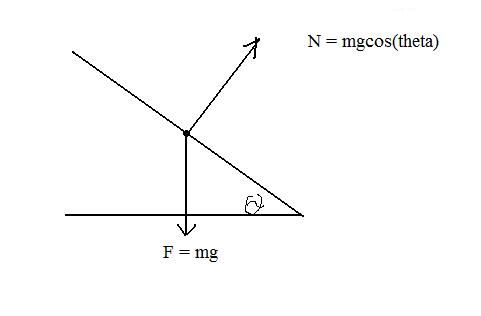Home History Physics Physics Continued Photos Bibliography
There are number of forces involved when
playing the cello. To make sound, you need to pull the bow across the
strings. On the bow is a force gravity, a force normal, a force
friction, and an x component of force gravity. On the fingerboard, are
the same forces. One thing to notice is that the directions of the
force friction switches whenever you change the direction of your bow.

Free body diagram of a cello in the ready position. The correct way of holding a bow results in a rather relaxed grip, where your arm and bow sort of hang in place, utilizing gravity to make a strong sound. There are times where you need to exert additional force to use different techniques. Likewise, you use gravity the same way to press down on the strings with your fingers to play notes. Less experienced players will grip the neck of the cello tightly so that they can press down on the strings to hit the right notes. This way of playing limits the speed and accuracy at which the player can actually hit the notes. The ideal way to grip the fingerboard is to actually not grip it, and instead let the weight of your arm to press down on the strings. This lets you change positions and hit different notes at an infinitely faster speed. It is also significantly less tiring.
When playing the cello, there is always a force friction. There is friction from where the bow and your fingers are in contact with the string. The faster and or louder you play, the greater the force friction. When playing in thumb position, the force friction becomes a major pain, both physically and mentally, because it hurts a lot, and is really hard when you have to play in thumb position and keep up with the rest of the symphony. Generally celli don't have to worry about thumb position unless its a solo or a piece of a greater magnitude of difficulty.

Free body diagram of a cello in the ready position. The correct way of holding a bow results in a rather relaxed grip, where your arm and bow sort of hang in place, utilizing gravity to make a strong sound. There are times where you need to exert additional force to use different techniques. Likewise, you use gravity the same way to press down on the strings with your fingers to play notes. Less experienced players will grip the neck of the cello tightly so that they can press down on the strings to hit the right notes. This way of playing limits the speed and accuracy at which the player can actually hit the notes. The ideal way to grip the fingerboard is to actually not grip it, and instead let the weight of your arm to press down on the strings. This lets you change positions and hit different notes at an infinitely faster speed. It is also significantly less tiring.
When playing the cello, there is always a force friction. There is friction from where the bow and your fingers are in contact with the string. The faster and or louder you play, the greater the force friction. When playing in thumb position, the force friction becomes a major pain, both physically and mentally, because it hurts a lot, and is really hard when you have to play in thumb position and keep up with the rest of the symphony. Generally celli don't have to worry about thumb position unless its a solo or a piece of a greater magnitude of difficulty.